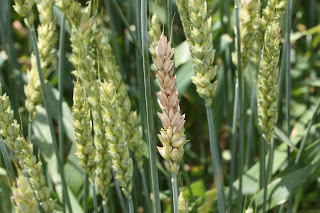In the past week, wheat development has moved into flag leaf emergence (Feekes 8-9, Zadoks 37-39) and in parts of the state past flag leaf and into the boot growth stage (Feekes 10, Zadoks 40). This is a critical period for making assessments for the need for foliar fungicides. Over the past few years, while we have seen yield responses of 7-10 bushels per acre with a well-timed foliar fungicide application during this period, we have typically seen this response for a susceptible wheat variety. In particular, this response has been due to control of powdery mildew (Figure 1).
Current Observations Across the State and in the Winter Wheat Variety Trials:
Note: special thanks to Karen Lackermann for this information and update.
We have started to receive some reports of powdery mildew on wheat, primarily in the northeastern part of the state and on susceptible varieties. We have also noted this disease at the Lancaster and Chilton variety trial locations. Overall, the level of powdery mildew (both incidence and severity) has been low and not necessarily on the most critical leaves like flag leaf, flag-1 leaf, or flag-2. The dry weather the past week or so seems to have limited disease development at this point in the growing season.
In observations for other diseases that can be controlled by foliar fungicides, we have noted the following at the winter wheat variety trials locations: septoria leaf blotch (Figure 2), wheat leaf rust (Figure 3), and wheat stripe rust (Figure 4). Overall, the severity of these diseases has been rather low (1-2%). In stems where the disease severity has been higher, the symptoms have been observed mostly in the lower canopy. Across the locations, we have noted wheat leaf rust at all four variety trial sites, however, the highest frequency of these observations have been from Janesville. We have seen septoria leaf blotch at all of our trial locations except the Chilton.
Figure 1. Powdery mildew of wheat.
Figure 2. Septoria leaf blotch of wheat.
Figure 3. Wheat leaf rust.
Figure 4. Wheat stripe rust.
As a reminder, in the March 26, 2009, Wisconsin Crop Manager article entitled,
“Do I Need to Spray a Foliar Fungicide in Wheat in 2009?”, we provide information regarding thresholds for powdery mildew, septoria leaf blotch, and wheat leaf rust. Current thresholds are also provided here to help guide decisions specific to Feekes 8 and post-Feekes 8 until Feekes 10.51 (flowering; Zadoks 60):
Powdery mildew, Feekes 8: check from the flag-2 leaf upward; the threshold is 5 pustules per leaf on the flag-2 leaf, on average.
Septoria leaf blocth, Feekes 8: check from the flag-2 leaf upward; the threshold is 25% of leaves with blotches.
Wheat leaf rust, Feekes 8: check from the flag-3 leaf upward; the threshold is 1 pustule per leaf, on average.
If wheat is already beyond Feekes 8, the recommendations up through Feekes 10.51 (flowering; Zadoks 60) are:
Powdery mildew, > Feekes 8 until Feekes 10.51: check from the flag-1 leaf upward; the threshold is 5 pustules per leaf on the flag-2 leaf, on average.
Septoria leaf blocth, > Feekes 8 until Feekes 10.51: check from the flag-2 leaf upward; the threshold is 25% of leaves with blotches.
Wheat leaf rust, > Feekes 8 until Feekes 10.51: check from the flag-2 leaf upward; the threshold is 1 pustule per leaf, on average.
Making the decisions to spray a foliar fungicide during this time requires knowledge of the wheat variety, active scouting of multiple locations in a field, proper identification of diseases, and an accurate assessment of the most critical leaves. For further information, this information is also discussed in a recent video available at the UW-Extension YouTube website:





































